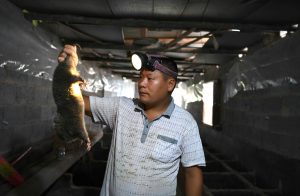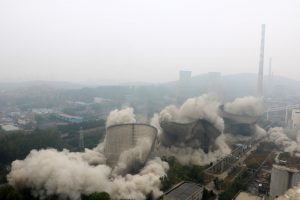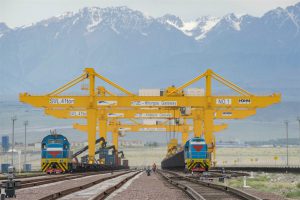As the Covid-19 outbreak stabilises in China, the central government is starting to talk about protecting the economy as well as mitigating the virus.
On 3 February, the politburo standing committee called for China to “tackle the epidemic with one hand, and develop the economy with the other”, and continue working “to realise the year’s economic and social goals”. It reiterated this approach on 12 February.
This year marks the end of the 13th Five Year Plan, which includes the goal of creating a “moderately prosperous society”. Over the plan period (2016-20), national GDP and average incomes were meant to double compared to 2010. For that to happen, GDP would need to grow around 6% this year. There is no doubt the government will produce a stimulus package to help. But a programme focused on infrastructure such as railways and roads will hamper the country’s transition to a sustainable economy.
Heavy industry on the mend
Covid-19 led to the extension of the Chinese New Year holidays to almost a month, which affected all parts of the economy. For heavy industry, the biggest uncertainty was demand. Downstream manufacturers and property developers have been slow to get back to work and the economy in general is sluggish. With demand not yet recovered, output of the raw materials produced by heavy industry, such as steel and aluminium, has fallen, though not precipitously. Steel mill utilisation rates remain at a normal level of about 70%, with no major reduction in output. First quarter steel output is expected to be down about 3%.
The return to work has picked up since 10 February. Coal consumption at six major power plants has increased slowly but steadily, indicating industry is getting back on track. Work on key infrastructure projects such as roads and bridges resumed on 15 February, with considerable fanfare. Experts answering questions online for the Ministry of Ecology and Environment said that despite widespread stoppages in construction, services and labour-intensive manufacturing, the heavy industries that supply these sectors continued to operate through the Chinese New Year and beyond. It’s not economical, for example, to stop furnaces in a steel factory for a week or two, so these continued to burn while producing less steel.
The analyst Lauri Myllyvirta pointed out that China has excess heavy industrial capacity and the sector will be able to ramp up to meet any increased demand, with industrial output and power consumption soon recovering. Experts have said the epidemic will mean a significant but short-term drop in energy consumption by heavy industry in the first quarter of the year, until the epidemic is brought under control.
Signs of an infrastructure-focused stimulus
Covid-19 is a new challenge for a Chinese economy already facing a slowdown. The government’s usual response to economic pressure is to use public spending to promote investment, particularly in infrastructure, and there are signs this will again be the case.
Tens of trillions of yuan of investment is planned in major projects across China this year, according to figures in the Economic Information Daily. The latest figures indicate that among the batch of special-purpose bonds (SPBs) issued by local governments earlier in the year, about 67% are to the infrastructure sector. SPBs are designed to help local governments inject funds into specific projects, such as irrigation and toll roads, to help boost their economies. Since January, local governments have issued about 950 billion yuan (US$136 billion) of SPBs, accounting for about 73.6% of the front-loaded SPB quota for this year.
Transport and energy infrastructure – including gas pipelines, oil refineries and nuclear power plants – are well represented in the project lists that some provinces have published. For example, Jiangsu province plans to invest 220 billion yuan (US$30 billion) in infrastructure out of the 540 billion yuan that is going into 240 major projects. Of the 233 major projects listed by Shandong province, 25 are road or rail construction and 16 are building projects. Meanwhile, Yunnan province announced an infrastructure construction plan at a recent press conference on Covid-19, including 100 billion yuan for high-speed rail.
Economic analysts expect to see infrastructure investment in China climb by as much as 8% to 9% this year.
Lauri Myllyvirta has calculated that the extended holiday cut China’s carbon emissions in the first two weeks of the lunar new year by a quarter year-on-year. These climate savings may be offset by a government stimulus package favouring infrastructure projects. According to Zhang Shuwei, director of the Draworld Environment Research Center: “If the government eases monetary policy and boosts infrastructure construction, we may see a nationwide increase in the energy intensity of the economy. It’s likely that energy consumption will not be affected, or will even jump quite a bit.”
If an economic stimulus is unavoidable, it should at least be targeted and not run contrary to China’s efforts to improve the structure of the economy. The service sector, which has been rocked by Covid-19, accounts for 54% of China’s GDP and provides huge numbers of jobs. Support tailored to it will be crucial for rebuilding resilience and confidence, and is in line with China’s economic transition.
Sustainable stimulus?
Chinese economists often debate how best to direct public finances in order to stimulate the economy. The coronavirus has brought something new to that discussion, by highlighting that public services like hospitals and schools suffer from a lack of resources and capacity to respond to emergencies.
Former mayor of Chongqing, Huang Qifan, wrote that government spending has long favoured transportation and construction, while overlooking public facilities and services. Huang believes spending on the latter would be a more effective way to boost GDP while also meeting public needs. He thinks government spending should incentivise consumption of public goods and services “to promote sustainable and high-quality economic growth.”
“When we look back at the lessons of the epidemic, will we acquire an awe at how nature, society and ourselves rely on each other?”
Heilongjiang and Jiangsu provinces are adding public health and other “catch-up” projects to their list of major projects, with funding support for those chosen. Nationally, the decision on whether to make improving the public health and emergency response systems a key target for government investment will be a test for policymakers.
Covid-19 is believed to have spread to humans via wild animal consumption. The public is now more aware of the importance to health of living in better harmony with the natural world. What is less recognised is that as well as bringing us disease, the overexploitation of nature also brings systemic risks that could cause disastrous “black swan” events. Four of the five major risks listed in the World Economic Forum’s 2020 Global Risks Report are environmental: climate change, biodiversity loss, extreme weather and the water crisis. As these risks interact rather than stand alone, they could cause a chain reaction.
If we are to increase our resilience, we need to fully understand these risks and ensure the facilities and mechanisms to respond are in place to prevent incidents escalating catastrophically. Environmental risks, like public health risks, need major investment to guard against. There are two aspects to this investment: one is spending on restoring our damaged environment and minimising further damage; the second is investment in environmentally-friendly technologies and industries that can change our mode of economic growth – to increase the “compatibility” of our society and economy with the environment.
How will we restore the economy once the epidemic has passed? If we direct government spending to high-carbon infrastructure construction and heavy industry, as usual, we will place ourselves at huge climate risk. This kind of investment is clearly not sustainable.
According to Zhang Shuwei: “The key is what we see when we look back at the lessons of the epidemic. Will we focus solely on the joy of victory, or acquire an awe at how nature, society and ourselves rely on each other? Our answer will lead us down different paths.”





![Farmers carry a sack of harvested clover to feed their animals, near Khuspur village, Punjab Province, Pakistan [image: Alamy]](https://dialogue.earth/content/uploads/2020/03/E62ENH-300x200.jpg)


